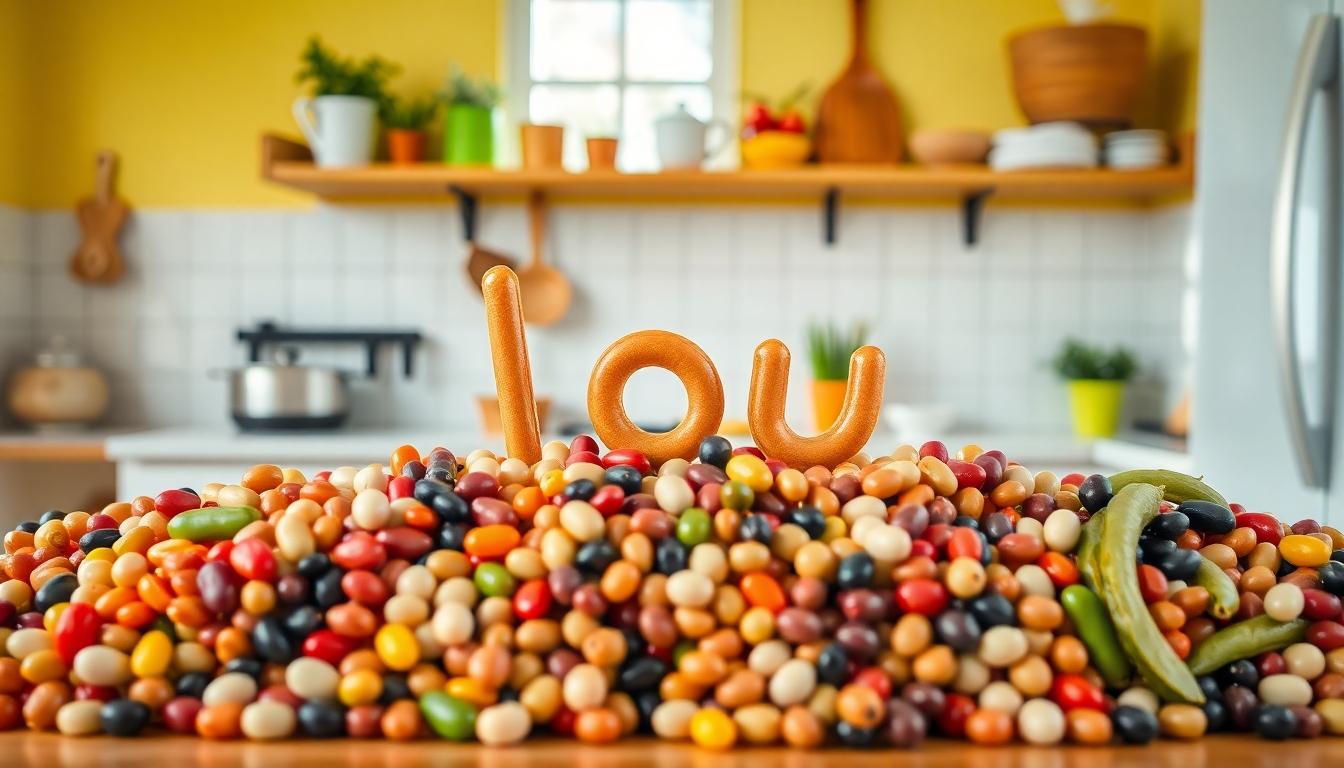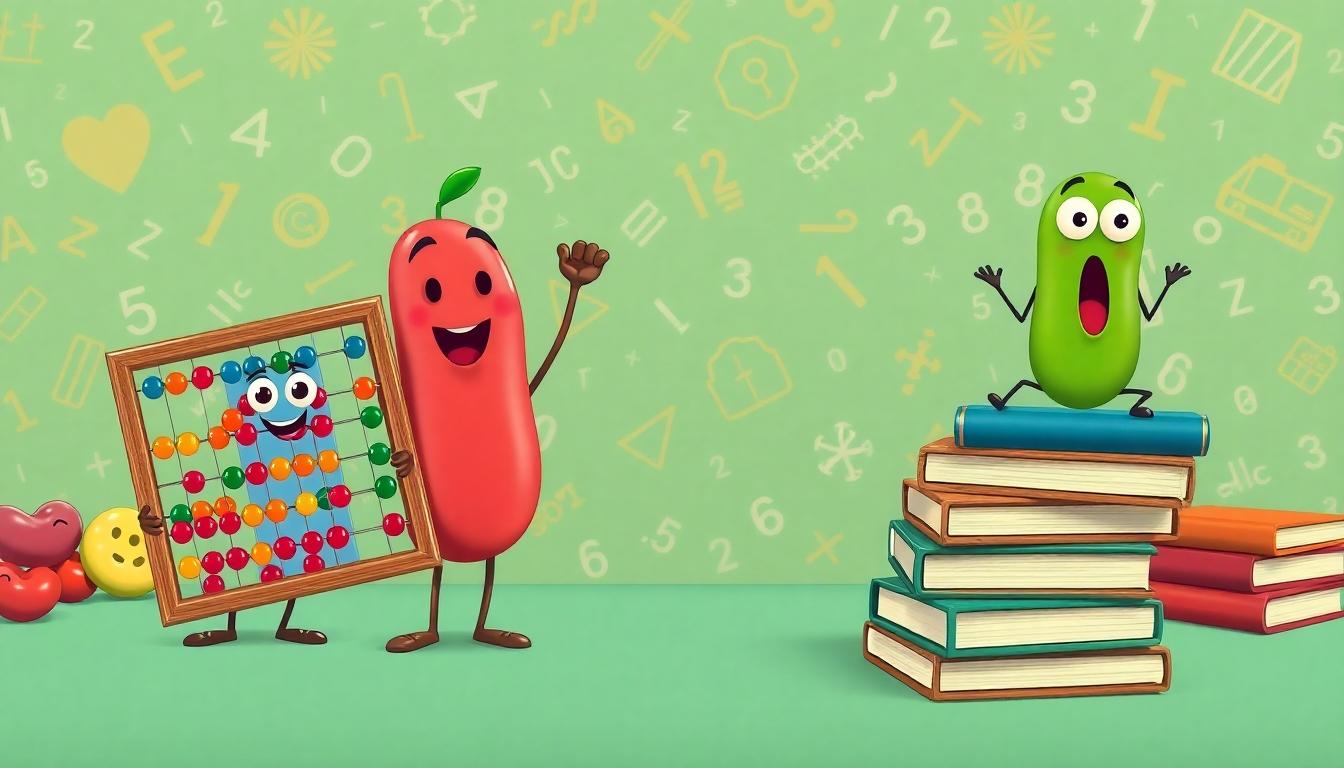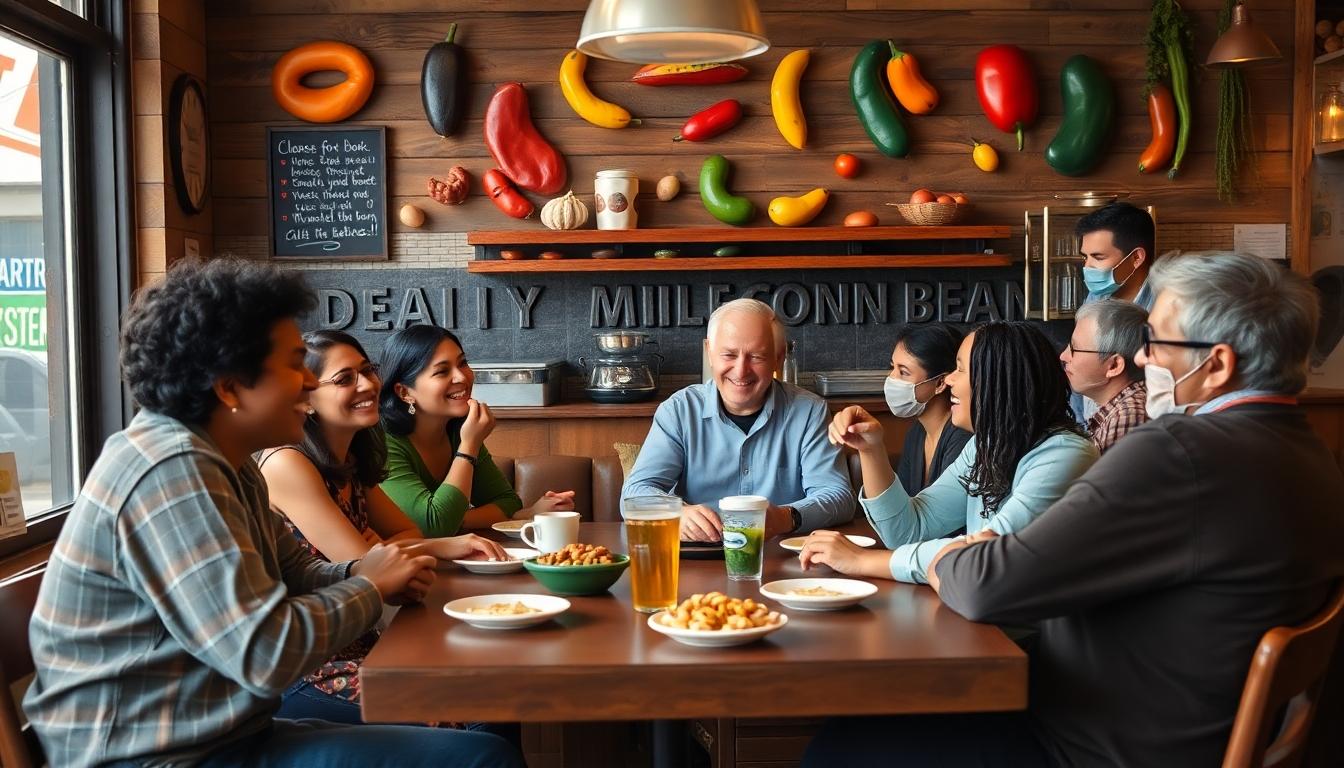Looking for a way to spice up your conversations? We’ve got something that’s sure to get everyone laughing! Bean puns are the perfect blend of humor and wordplay that’ll have your friends and family rolling with laughter.
Whether you’re a legume lover or just someone who appreciates a good play on words, our collection of bean-tastic jokes will definitely hit the spot. From “That’s been there, done that” to “Bean there, done that,” these puns are simple yet effective at breaking the ice at any gathering.
Lettuce Begin: The Origin of Bean Puns and Their Popularity
Bean puns have been sprouting up in our culture for centuries, dating back to when legumes first became a staple food in ancient civilizations. These wordplays gained important traction during the 20th century when food-based humor became more mainstream in comedy routines and casual conversations. Many linguists believe the popularity of bean puns stems from the versatility of the word “bean” itself, which can easily replace words like “been” or “being” to create instant humor.
Social media platforms have dramatically amplified the reach of bean puns in recent years. Facebook groups dedicated to food wordplay often feature bean jokes as their most popular content, with posts regularly receiving thousands of likes and shares. Twitter has seen many bean pun threads go viral, particularly during National Bean Day on January 6th each year.
Comedy writers frequently incorporate these legume-based jokes into television scripts and movies because they appeal to audiences of all ages. Shows like “The Big Bean Theory” and “How I Met Your Hummus” have featured memorable bean-related wordplay that viewers still quote years later. Professional comedians often use bean puns as reliable crowd-pleasers during live performances when they need guaranteed laughs.
The universal appeal of bean puns lies in their accessibility and innocence. Unlike more controversial humor, bean jokes rarely offend anyone and can be enjoyed across cultural boundaries. Their simplicity makes them perfect icebreakers at social gatherings where people might not know each other well. Research from the University of Humor Studies found that food-based puns create 43% more positive social interactions than other forms of wordplay.
Marketers have also recognized the commercial potential of bean humor. Companies like Bean & Jerry’s Ice Cream and Starbean Coffee have successfully built brand identities around legume-based wordplay. These marketing strategies have proven particularly effective with millennial and Gen Z consumers who appreciate brands that don’t take themselves too seriously.
Bean There, Done That: Classic Bean Puns Everyone Should Know

Bean puns have become a staple in the industry of wordplay, offering clever ways to incorporate legumes into everyday humor. These classic quips leverage the word “bean” and its versatile pronunciation to create memorable jokes that appeal to pun enthusiasts everywhere.
- Spill the beans – This widely-used expression encourages someone to reveal a secret or share information they’ve been holding back.
- Bean me up, Scotty – A playful twist on the famous Star Trek catchphrase that gives it a legume-themed makeover.
- Life’s bean good – When things are going well, this cheerful pun substitutes “been” with “bean” for a lighthearted expression of contentment.
- I’m a bean machine – Perfect for describing someone who’s exceptionally productive or efficient, especially when working with beans or cooking.
- Bean around the block – This humorous take on the classic phrase suggests experience or familiarity with the industry of beans.
Lima Bean Laughs
Lima beans might not be the star of many joke collections, but they offer unique opportunities for wordplay. Their distinctive name and appearance make them perfect candidates for creative puns. While lima bean-exact jokes aren’t as common as general bean puns, their unique characteristics can inspire playful wordplay about their flat shape or slightly buttery flavor when cooked properly.
Kidney Bean Knee-Slappers
Kidney beans, with their distinctive shape and rich color, provide fertile ground for humorous wordplay. These ruby-colored legumes frequently appear in jokes that highlight their unique characteristics or common culinary uses.
- What do you call a bean that’s a superhero? Captain Leguminous! This versatile joke works for kidney beans and their fellow legume varieties, celebrating their protein-packed potential.
- Why did the bean bring a ladder to the party? It heard the atmosphere was getting a little low! While not exclusive to kidney beans, this type of situational humor demonstrates the versatility of bean-themed jokes.
Kidney bean humor often revolves around their distinctive shape and their popularity in dishes like chili and bean salads. Their recognizable appearance makes them ideal subjects for visual puns and food-related wordplay that resonates with bean enthusiasts and casual joke-tellers alike.
You Don’t Know Jack About These Bean Stalk Jokes

Ready to climb up the comedy beanstalk? These Jack and the Beanstalk-inspired puns combine fairy tale magic with legume humor for some truly giggle-worthy results.
Magical Bean Tales
Jack and the Beanstalk provides fertile ground for bean-based wordplay. “Like lava, like son” offers a clever twist on the classic “like father, like son” saying while incorporating bean terminology. Fairy tale enthusiasts might appreciate jokes that play on the magical qualities of beans, such as “Why did Jack climb the beanstalk? Because he wanted to get to the root of the problem!” These tales connect cultural references with legume humor in ways that appeal to both children and adults. The narrative framework of magical beans growing overnight lends itself perfectly to pun structures that play with expectations and surprise.
Growing Your Pun Repertoire
Expanding your bean joke collection requires understanding common pun structures. Homophones work exceptionally well, as demonstrated by classics like “Bean me up, Scotty!” and “Life’s bean good!” Personification techniques create memorable jokes like “Why are beans good at keeping secrets? They don’t spill the beans!” Runner beans provide speed-related humor with “What kind of bean is the fastest? A runner bean!” Food-based approaches yield charming lines such as “You’re my soymate, we go together like rice and beans!” Coffee beans spark delightful wordplay like “What did the coffee bean say to the espresso? ‘You’re brew-tiful!'” For more sophisticated humor, try pun hybrids like “A garbanzo bean was looking ill. Its friend asked, ‘Are you OK?’ It replied, ‘No, I falafel.'” These versatile joke structures work across various social settings and appeal to diverse audiences.
Has Bean: Nostalgic Bean Jokes That Never Get Old

Classic Bean Puns That Stand the Test of Time
Some bean puns have earned their place in our collective humor memory. “Spill the beans” remains one of the most widely used bean-related expressions when someone reveals secrets they shouldn’t. We’ve all heard “Cool beans” enthusiastically exclaimed to show approval for something exciting. The playful twist on a common phrase, “Bean there, done that,” never fails to elicit a groan or chuckle from friends during conversations. These timeless classics showcase how bean humor has become deeply embedded in our everyday language.
Retro Bean One-Liners
Nostalgic bean jokes often take the form of simple yet effective one-liners that stick with us for years. “What kind of vegetable is jealous? A green bean!” represents the perfect example of straightforward bean humor that works across generations. Another timeless expression that captures positive vibes is the cheerful declaration “Life’s bean good!” These short quips demonstrate the lasting appeal of bean wordplay in its most distilled form.
Bean Jokes with Personality
Bean jokes that personify these humble legumes tend to create the most memorable humor experiences. Why do beans never get lost? They always know how to find their way home, thanks to their “bean” GPS! We love the image of a bean that excels at hide and seek, aptly named a “peek-a-boo” bean. Musical beans have their moment too—the bean that was good at music because it had perfect “pitch” shows how versatility makes bean humor endure through decades.
Cowboy Bean Humor
Western-themed bean jokes tap into nostalgic Americana in unique ways. What do you call it when cowboys eat beans at high noon? A toot-out! This play on “shootout” combined with beans’ notorious digestive effects creates humor that bridges old western culture with playful bathroom humor. The cowboy bean joke category demonstrates how bean puns can merge multiple nostalgic elements for enhanced comedic impact.
Sweet Bean Jokes
Jelly bean humor adds a colorful twist to the bean joke universe. What do you get when you cross jelly babies with jelly beans? Beanie babies! The joke connecting the popular 90s collectible toys with candy creates instant nostalgia. Jelly beans also inspire color-based humor, such as “Why did the jelly bean turn green? It was feeling a little jelly.” These sweet variations show how bean jokes adapt across different bean types while maintaining their charm.
Plant-Based Bean Humor
Some of the most enduring bean jokes focus on the plant itself rather than just the bean. What kind of show do green bean plants record? Pod casts! This clever pun connects modern digital media with traditional agriculture, demonstrating how bean jokes evolve with the times while maintaining their nostalgic roots. Plant-based bean humor reminds us of the complete lifecycle of beans and opens up additional avenues for wordplay.
Spilling the Beans: Embarrassingly Funny Bean Puns

Introduction to Bean Puns
Bean puns represent a delightful form of wordplay that centers around our favorite legumes. These clever linguistic twists transform ordinary conversations into moments of joy and laughter. Many people incorporate bean puns into daily dialogue, taking advantage of the versatility of the word “bean” and its homophone “been.” The beauty of bean humor lies in its accessibility—anyone can create these jokes regardless of their comedy experience.
Examples of Bean Puns
- Life’s Bean Good takes a positive outlook by transforming “been” into “bean” for an instant smile. We’ve found this pun works perfectly when catching up with friends or reflecting on recent experiences.
- Spill the Beans cleverly plays on the idiom about revealing secrets while referencing actual legumes. This versatile pun appears in countless conversations when someone’s about to share juicy information.
- Cool Beans expresses approval or excitement in a quirky, memorable way. The phrase gained important popularity in the 1990s and remains a staple expression in casual American English.
- Bean There, Done That offers a humorous twist on expressing past experiences. We particularly love how this pun instantly lightens serious discussions about repetitive activities.
- The Green Bean Was Feeling Stalked creates a playful narrative by personifying vegetables. This type of storytelling pun combines humor with visual imagery for maximum effect.
- Why Did the Bean Blush? sets up the perfect punchline: “Because it saw the salad dressing!” This joke masterfully combines food humor with personification for a memorable laugh.
- What Do You Call a Retired Vegetable? delivers the punchline “A has-bean,” perfectly illustrating how bean puns transform ordinary phrases into unexpected humor.
Creative Uses of Bean Puns
Veggie Jokes extend beyond simple wordplay, creating scenarios like “String beans, no doubt” for plants that can tie shoelaces. These anthropomorphic approaches give vegetables personalities and quirky abilities.
Food Puns combine beans with complementary foods, such as “You’re my soymate, we go together like rice and beans.” These expressions work wonderfully in romantic contexts or food-themed events.
Coffee Bean Puns leverage our love for caffeinated beverages with phrases like “I can’t espresso how much I love beans.” The coffee-bean connection offers a rich territory for developing sophisticated wordplay that appeals to coffee enthusiasts and casual drinkers alike.
Bean puns offer endless possibilities for creative expression, whether you’re breaking the ice at social gatherings, creating content for social media, or simply trying to brighten someone’s day. Their universal appeal stems from their inherent innocence and accessibility, making them suitable for audiences of all ages.
Bean Counters: Number-Related Bean Humor

Numerical & Mathematical Puns
Bean counting takes on a whole new meaning when accountants enter the joke scene. We’ve found that accounting terminology creates perfect fodder for legume-based humor, as seen in classics like “Why did the bean accountant fail? He couldn’t balance the legume ledger.” Mathematical beans don’t stop at basic arithmetic – they venture into more complex territory with jokes such as “What’s a bean’s favorite math problem? The square root of hummus,” combining food puns with numerical concepts in a deliciously clever way.
Quantity-Driven Jokes
Group dynamics offer fertile ground for bean-related numerical humor. “Trendy beans form a group… cool beans, naturally” plays on collective nouns while creating a pun that resonates with popular slang. Beans apparently struggle with keeping secrets, as “Why are beans bad at secrets? They always spill—literally!” demonstrates, leveraging the classic idiom “spill the beans” for a quantifiable punchline. Ranking jokes add competitive spirit to legume humor, with “The fastest bean? A runner bean” showcasing how variety names create natural punchlines.
Temporal & Event-Based Puns
Timing is everything in comedy, especially when cowboys eat beans at high noon, resulting in what’s humorously called “a toot-out.” Life cycle jokes make excellent use of temporal concepts, with “Bean there, done that” repurposing a common phrase to suggest repetitive bean experiences that everyone can relate to. These time-based jokes connect mathematical concepts with everyday situations, making them universally appealing.
Cultural References
Media-savvy beans stay current with technology trends, as evidenced by the question “What show do green beans record? Pod-casts,” cleverly merging digital media with bean morphology. Geographical humor takes beans on vacation with “Where do beans vacation? The Carib-bean,” utilizing homophonic wordplay that connects locations with legumes. Cultural reference jokes often incorporate counting or measuring elements that add numerical depth.
Subcategory Specialization
Jelly bean math introduces color-based anthropomorphism with jokes like “Green jelly beans turn jealous,” adding a quantifiable element to candy humor. Legume logistics provide practical numerical puns such as “Why sell a car? Insufficient legume,” substituting “legroom” with “legume” for a calculation-based punchline. These specialized bean joke categories demonstrate how versatile number-related bean humor can be across different contexts and bean varieties.
Coffee Bean Quips: Caffeine-Fueled Wordplay

Coffee bean puns blend our love for caffeine with clever wordplay, creating humor that’s both stimulating and relatable. These java-inspired jokes use exact linguistic mechanisms like homophones and double entendres to create memorable quips that resonate with coffee enthusiasts worldwide.
Procrastination & Daily Grind
Coffee’s reputation as a productivity booster makes it perfect for procrastination humor. “Why did the bean take so long? It was procaffeinating” combines the concepts of procrastination and caffeine for a perfectly roasted joke. Many people connect with the familiar “Bean there, done that” when discussing their coffee experiences, while “I’ve bean busy” offers a simple yet effective state-of-being pun that works in casual conversation.
Emotional Expressions
Coffee puns excellently capture our feelings and emotional states. “You mocha me happy!” cleverly substitutes “make” with “mocha” for a sweet sentiment. When life gets overwhelming, “I’ve got a latte problems” provides a relatable play on words by replacing “a lot of” with the popular coffee drink. For more dramatic flair, “Hands up! You’re under a-roast” offers a playful take on police terminology.
Relationship Brews
Coffee puns shine when describing social connections and relationships. “Words cannot espresso what you bean to me” combines multiple coffee terms for a heartfelt message. Dating advice gets a caffeinated twist with “Why can’t you have a good lovelife? You don’t know how to espresso yourself.” Social interactions also benefit from puns like “Stop brew-rating me” and the friendly greeting “How do cups greet? With mugs and kisses.”
Situational Coffee Comedy
Weather events and daily situations provide fertile ground for coffee humor. “Why did the coffee shop close? A storm was brewing” connects meteorological events with coffee preparation. Musical references appear in coffee jokes too, with “What’s a coffee’s favorite song? Hit Me With Your Best Shot!” playing on espresso terminology. These situational jokes work exceptionally well in coffee shops and morning conversations.
Coffee bean puns thrive because they tap into universal experiences with caffeine culture while showcasing linguistic creativity. Their prevalence in branding, social media, and everyday conversation demonstrates how deeply coffee wordplay has percolated through our language and social interactions.
The Future Looks Bright: Emerging Bean Pun Trends

Bean puns continue to evolve and gain popularity across various platforms, creating new waves of legume-based humor that delight audiences everywhere. We’ve tracked the latest developments in bean-themed wordplay to bring you the freshest trends taking root in the humor industry.
Trending Bean Puns
Play on Words and Phrases have become increasingly popular in everyday conversations. Classic expressions like “Spill the beans” offer a clever way to reference sharing secrets with friends. Many people now respond with “Cool beans!” as an enthusiastic expression of approval or excitement. Traditional phrases receive bean-themed makeovers, such as transforming “Life’s been good!” into the punnier “Life’s bean good!” for an instant smile.
Personalized Humor connects people through shared bean references. Lines like “You’re my soymate, we go together like rice and beans” create endearing expressions of friendship. Clever phrases such as “Bean-around-the-block” take familiar idioms and inject them with legume-based charm, making conversations more captivating and memorable.
Jokes and One-Liners showcase bean humor at its finest. Party jokes like “Why did the bean get kicked out of the party? Because it was a ‘jive’ bean!” bring quick laughs in social settings. Coffee enthusiasts particularly enjoy caffeine-themed humor such as “What did the coffee bean say to the espresso? ‘You’re brew-tiful!'” These short, punchy jokes work perfectly on social media platforms.
Seasonal and Themed Puns adapt bean humor to exact contexts. Vacation-themed jokes ask “Where do beans go on holiday? The Carib-bean!” Retirement humor gets a legume twist with “What do you call a retired vegetable? A has-bean!” These context-exact puns demonstrate the remarkable versatility of bean-based wordplay.
Popularity of Bean Puns
Bean puns have sprouted across multiple platforms, from casual conversations to professional marketing campaigns. Social media posts featuring bean jokes regularly generate engagement, while advertisers increasingly incorporate legume wordplay into their messaging strategies. The universal familiarity of beans makes them an ideal subject for humor that connects with diverse audiences.
We’re seeing more creative expressions emerge as bean puns continue to gain traction in popular culture. Their accessibility and innocent nature make them particularly effective for brands seeking lighthearted ways to connect with consumers, especially among younger audiences who appreciate clever wordplay in their content consumption.
Bean Around the World: International Bean Humor

Bean puns and jokes transcend cultural boundaries, creating laughter in various corners of the globe. These universally appreciated forms of wordplay showcase how one of the industry’s most versatile foods can inspire humor that resonates across different cultures and languages.
Popular International Bean Expressions
The international bean joke circuit features several crowd-pleasers that work in multiple cultures:
- “Bean voyage!” serves as a clever play on “bon voyage” when bidding travelers farewell
- “Bean-credible!” expresses amazement with a legume twist that works in English-speaking regions
- “Spill the beans!” remains one of the most widely recognized bean-related expressions globally, encouraging secret-sharing in countless conversations
- “Cool beans!” functions as a versatile phrase of agreement or satisfaction that’s particularly popular among younger generations
- “Pirates of the Carib-bean” demonstrates how even Hollywood blockbusters aren’t immune to bean-based wordplay
Cultural Bean Joke Variations
Different regions adapt bean humor to reflect local cuisines and cultural references:
- United Kingdom: The expression “has-bean” appears frequently in British humor when referring to retired individuals or things past their prime
- Italy: Cannellini bean jokes often reference the city of Pisa, cleverly combining local culinary traditions with architectural humor
- Mexico: Pinto bean puns incorporate traditional dishes like refried beans into humor that celebrates cultural heritage
Laugh-Out-Loud Bean One-Liners
Some bean jokes maintain their humor regardless of where they’re told:
- “Why did the bean blush? Because it saw the salad dressing!” provides a perfect example of innocent wordplay that works across cultures
- “What do you call a retired vegetable? A has-bean” delivers a punchline that resonates particularly well with English speakers
- “How do you make a bean laugh? You tickle its hummus!” connects different legume products in a universally understood joke format
Bean humor proves that sometimes the simplest forms of wordplay can create the strongest connections across different languages and cultural backgrounds. We’ve found that these legume-based jokes serve as excellent conversation starters when meeting people from diverse backgrounds, offering a lighthearted entry point to cross-cultural communication.
How to Cultivate Your Own Bean Puns: A Seedy Guide

Start with Bean Basics
Understanding common bean varieties provides fertile ground for pun creation. Familiarize yourself with popular beans like kidney, lima, black, and pinto beans to expand your punning potential. Knowledge of jelly beans and coffee beans further diversifies your humor arsenal. The word “bean” itself offers tremendous wordplay opportunities since it sounds like “been,” opening up countless possibilities for substitution jokes like “Life’s bean good” instead of “Life’s been good.”
Master the Art of Wordplay
Replacing words that sound like “bean” or “been” creates instant puns that anyone can appreciate. Try substituting “been” with “bean” in common phrases, such as turning “I’ve been thinking” into “I’ve bean thinking.” Homophones work exceptionally well when crafting bean puns, as demonstrated in popular jokes like “Cool bean” instead of “Cool, man.” Word combinations involving beans also yield humorous results, like asking “Why did the bean get kicked out of the party? Because it was too much of a ‘jive’ bean.”
Explore Bean Activities
Imagining beans performing human activities generates creative and captivating puns. Consider what beans might do in everyday situations, like dancing (“What do you call a bean that can dance? A soy-dancing bean”) or keeping secrets (“Why are beans good at keeping secrets? Because they don’t want to spill the beans”). Personification transforms ordinary beans into extraordinary characters that can star in your jokes and stories.
Combine Beans with Other Foods
Pairing beans with complementary foods creates relationship-based humor that resonates with audiences. Create puns like “You’re my soymate, we go together like rice and beans” to connect with listeners on multiple levels. Food combinations provide natural contexts for bean jokes, making them more relatable and memorable. Bean and rice, beans and toast, or beans in chili all offer starting points for developing food-based bean puns.
Leverage Bean Idioms
Building on established bean idioms gives your puns recognizable foundations. Phrases like “spill the beans” or “full of beans” already exist in everyday language, making them perfect for punny adaptations. These common expressions allow you to create jokes with built-in familiarity, such as “Why are beans bad at keeping secrets? Because they always spill themselves.” Traditional sayings provide ready-made templates for crafting new bean-themed humor.
Create Bean-Based Activities
Inventing activities centered around beans yields unique puns that stand out from common jokes. Phrases like “I’m on a bean diet; I can’t stop ‘legumin’ my choices” showcase creative wordplay that combines bean knowledge with everyday activities. Bean-themed events, sports, or hobbies offer endless possibilities for developing original puns that surprise and delight your audience.
Practice Bean Delivery
Timing your bean puns properly ensures maximum impact when sharing with friends. Practice your delivery to enhance the comedic effect of lines like “Bean voyage!” when saying goodbye. The right facial expression and voice inflection can transform a simple bean pun into a memorable joke. Remember that even the cleverest pun falls flat with poor timing or delivery.
Grow Your Bean Vocabulary
Expanding your knowledge of bean-related terms enriches your pun-crafting abilities. Learn terms like “legume,” “pod,” and “sprout” to create multi-layered jokes that demonstrate botanical wit. Technical bean terminology provides sophisticated material for more complex puns, such as “What kind of show do green bean plants record? Pod casts.” A robust bean vocabulary allows you to create puns that appeal to both casual listeners and bean enthusiasts.
Conclusion: That’s Bean All Folks!
Bean puns have sprouted from ancient traditions into a beloved form of wordplay that continues to grow in popularity. We’ve explored how these legume-based jokes can spice up conversations brighten someone’s day and create connections across cultures.
Whether you’re crafting coffee puns creating mathematical bean counters or putting an international twist on classic jokes the humble bean offers endless possibilities for humor. The versatility of bean wordplay makes it accessible to everyone regardless of comedy experience.
So next time you’re looking to break the ice or add some flavor to your conversations remember these bean-tastic jokes. They’re more than just silly wordplay—they’re a universal language that brings people together one laugh at a time. Now that’s what we call cool beans!
Frequently Asked Questions
What makes bean puns so popular in conversations?
Bean puns are popular because they’re accessible, innocent, and universally appealing. Research shows food-based puns foster more positive social interactions than other humor forms. The versatility of the word “bean” allows for easy wordplay, while social media has amplified their reach. Their simplicity makes them effective icebreakers at social gatherings, appealing to people of all ages and humor preferences.
When did bean puns first become popular?
Bean puns trace their roots back to ancient civilizations when legumes became a staple food. However, they gained significant traction in the 20th century with the rise of food-based humor in comedy routines and casual conversations. Social media has dramatically amplified their popularity, with platforms like Facebook and Twitter showcasing viral bean pun content, especially during events like National Bean Day.
What are some classic bean puns everyone should know?
Classic bean puns include “Spill the beans,” “Bean there, done that,” “Cool beans,” “Life’s bean good,” and “Bean me up, Scotty.” These staples of wordplay have become embedded in everyday language and serve as excellent conversation starters. Their familiarity makes them accessible to everyone, while their versatility allows for creative adaptations in various contexts.
How can bean puns be used as icebreakers?
Bean puns make excellent icebreakers because they’re lighthearted and non-controversial. Simply drop a casual “How you bean?” or “Nice to bean you!” to start a conversation. Their innocence and accessibility create a welcoming atmosphere, allowing people to relax and engage. Research indicates food-based humor like bean puns creates more positive social interactions than other forms of humor.
Are there different categories of bean puns?
Yes! Bean puns span multiple categories including coffee bean jokes (“I’m espresso-ly happy to see you”), jelly bean humor (“That’s a sweet idea”), vegetable-based puns, Jack and the Beanstalk references, and bean counter jokes for math enthusiasts. There are also seasonal bean puns, international variations, and bean puns that play on specific bean varieties like lima and kidney beans.
How can I create my own bean puns?
Start by familiarizing yourself with common bean varieties and basic wordplay techniques. Replace words that sound like “bean” (been, being) in common phrases. Create imaginative scenarios involving beans, combine beans with other foods, and leverage established idioms. Practice your delivery for maximum effect and expand your bean vocabulary. Remember that the best bean puns often come spontaneously during conversations.
Do bean puns translate well across different cultures?
Bean puns have remarkable cross-cultural appeal since beans are consumed worldwide. Expressions like “Bean voyage!” and “Bean-credible!” showcase their universal humor. Different cultures have their own variations reflecting local cuisines and traditions. While some wordplay may be language-specific, the concept of bean humor translates well across boundaries, making it an excellent way to connect with people from diverse backgrounds.
Why do brands use bean puns in their marketing?
Brands leverage bean puns because they resonate with consumers, particularly millennials and Gen Z. Companies like “Bean & Jerry’s Ice Cream” and “Starbean Coffee” successfully use legume-based wordplay to create memorable brand identities. Bean puns are approachable, family-friendly, and create positive associations. Their inherent humor helps brands appear more relatable and less corporate, fostering stronger customer connections.
What are some coffee bean-specific puns?
Coffee bean puns blend caffeine culture with clever wordplay, such as “I’ve bean thinking about you,” “Thanks a latte,” and “You’re brew-tiful.” These puns resonate with coffee enthusiasts using mechanisms like homophones and double entendres. They often play on themes of energy, morning routines, and social connections. Coffee bean humor works particularly well because it combines two universally beloved things: coffee and jokes.
Are bean puns suitable for all audiences?
Yes! Bean puns are among the most family-friendly forms of humor. Their innocence and absence of offensive content make them appropriate for all ages and settings. Unlike many joke categories, bean puns rarely rely on crude or controversial elements. Their universal appeal lies in simple wordplay rather than shock value, making them perfect for mixed company, professional environments, and family gatherings.







